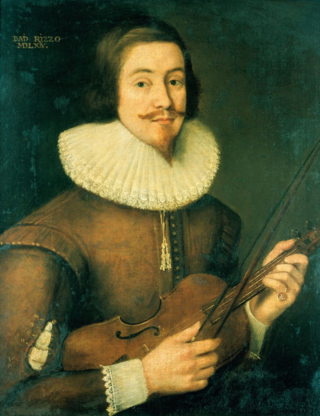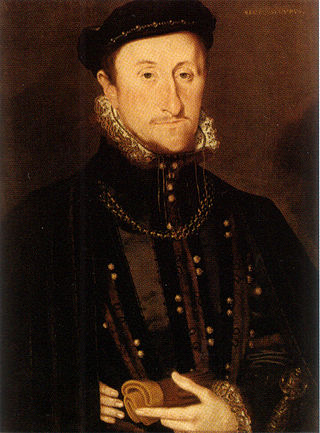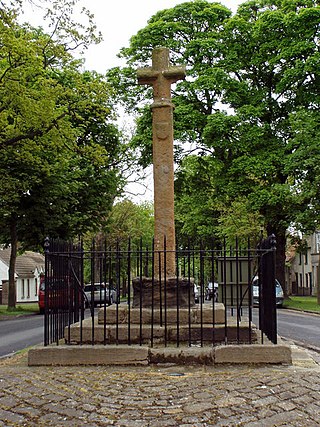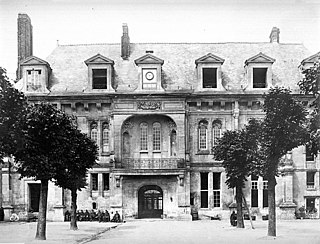Related Research Articles

David Rizzio or Riccio was an Italian courtier, born in Pancalieri close to Turin, a descendant of an ancient and noble family still living in Piedmont, the Riccio Counts di San Paolo e Solbrito, who rose to become the private secretary of Mary, Queen of Scots. Mary's husband, Lord Darnley, is said to have been jealous of their friendship because of rumours that Rizzio had impregnated Mary, and he joined in a conspiracy of Protestant nobles to murder him, led by Patrick Ruthven, 3rd Lord Ruthven. Mary was having dinner with Rizzio and a few ladies-in-waiting when Darnley joined them, accused his wife of adultery and then had a group murder Rizzio, who was hiding behind Mary. Mary was held at gunpoint and Rizzio was stabbed numerous times. His body took 57 dagger wounds. The murder was the catalyst of the downfall of Darnley, and had serious consequences for Mary's subsequent reign.

James Stewart, 1st Earl of Moray was a member of the House of Stewart as the illegitimate son of King James V of Scotland. At times a supporter of his half-sister Mary, Queen of Scots, he was the regent of Scotland for his half-nephew, the infant King James VI, from 1567 until his assassination in 1570. He was the first head of government to be assassinated with a firearm.

James Hamilton, 1st Duke of Châtellerault, 2nd Earl of Arran, was a Scottish nobleman and head of the House of Hamilton. A great-grandson of King James II of Scotland, he was heir presumptive to the Scottish throne. Arran was Regent of Scotland during the minority of Mary, Queen of Scots from 1543 to 1554, when he lost the regency to Mary of Guise. At first pro-English and Protestant, he converted to Catholicism in 1543 and supported a pro-French policy. He reluctantly agreed to Mary's marriage to Francis, eldest son of King Henry II of France, and was rewarded by Henry by being made Duke of Châtellerault in 1549. During the Scottish Reformation, Châtellerault joined the Protestant Lords of the Congregation to oppose the regency of Mary of Guise, and lost his French dukedom as a result.

James Hamilton, 3rd Earl of Arran (1537–1609) was a Scottish nobleman and soldier who opposed the French-dominated regency during the Scottish Reformation. He was the eldest son of James Hamilton, Duke of Châtellerault, sometime regent of Scotland. He was of royal descent, and at times was third or fourth in succession to the Scottish crown; several royal marriages were proposed for him, but he eventually never married. He went to France with Mary, Queen of Scots, where he commanded the Scots Guards. After returning to Scotland, he became a leader of the Protestant party against Mary and her French supporters. However, he went insane in 1562 and was confined for the rest of his life.

The Lord Justice Clerk is the second most senior judge in Scotland, after the Lord President of the Court of Session.
George Gordon, 5th Earl of Huntly, was Lord Chancellor of Scotland and major conspirator of his time.
Patrick Ruthven, 3rd Lord Ruthven played an important part in the political intrigues of 16th century Scotland. He succeeded to the lordship in December 1552. The Ruthven lordship encompassed the offices of Provost and Constable of Perth, and Sheriff of Strathearn.
Robert Stewart, 1st Earl of Orkney and Lord of Zetland (Shetland) was a recognised illegitimate son of James V, King of Scotland, and his mistress Eupheme Elphinstone. Robert Stewart was half-brother to Mary, Queen of Scots and uncle to James VI and I of Scotland and England.
Sir Lewis Bellenden of Auchnole and Broughton was a Scottish lawyer, who succeeded his father as Lord Justice Clerk on 15 March 1577.
Lady Jean Stewart, was an illegitimate daughter of King James V of Scotland by his mistress, Elizabeth Bethune.
Sir James MacGill, Lord Rankeillor of Nether Rankeillour. was a Scottish courtier and Senator of the College of Justice.

John Cockburn, laird of Ormiston, East Lothian, Scotland, was an early supporter of the Scottish Reformation. He was the eldest son of William Cockburn of Ormiston and Janet Somerville. John was usually called "Ormiston." During his lifetime there was also a laird of Ormiston in Teviotdale near Eckford, a member of the rival Hepburn family.
Thomas Bellenden or Bannatyne of Auchnoule, courtier of James V of Scotland, Judge from 1535, Director of Chancery from 1538, Lord Justice Clerk from 1539, member of the royal council, ambassador to England, and Protestant sympathizer. Bellenden was a graduate of the University of Paris, and early in his career used the title "Master."
The Comptroller of Scotland was a post in the pre-Union government of Scotland.
James Stewart, 1st Lord Doune (1529-1590) was a Scottish landowner.

John Stewart, Commendator of Coldingham (1531–1563) was a Scottish landowner.
Timothy Cagnioli was an Italian merchant and banker in Scotland.
Sir John Wishart of Pitarrow was a Scottish lawyer, courtier, comptroller of the exchequer, and rebel.

Bartolomew de Villemore was a French courtier and administrator to Mary of Guise, the mother of Mary, Queen of Scots.
Gold has been mined in Scotland for centuries. There was a short-lived gold rush in 1852 at Auchtermuchty and Kinnesswood, and another in 1869 at Baile An Or on the Kildonan burn in Helmsdale in Sutherland. There have been several attempts to run commercial mines. In the Lowther Hills, Leadhills, and Wanlockhead areas gold prospecting and the extraction of lead metal went hand in hand. From 1424, under the Royal Mines Act, until 1592, gold and silver mined in Scotland were deemed to belong to the crown. The 1592 Act vested rights for gold, silver, lead, copper, tin, and other minerals in the king's feudal tenants or other leaseholders, who would pay 10% of any profit to the crown. The Act also established a Master of Metals as a crown officer, a position held from June 1592 by Lord Menmuir. followed by Thomas Hamilton of Monkland in March 1607.
References
- The Scots' Peerage, by Sir James Balfour Paul, Edinburgh, 1905, vol.ii, p. 64/5.
- Melrose Regality Records, edited by Charles S. Romanes, C.A., Edinburgh, 1917, vol.3, p. 374/5.
- ↑ Joseph Bain, Calendar State Papers Scotland, vol. 1 (Edinburgh, 1898), pp. 193–4.
- ↑ Thomas Thomson, Discours Particulier D'Escosse (Edinburgh, Bannatyne Club, 1824), p. 32.
- ↑ Edmund Lodge, Illustrations of British History, Biography, and Manners, vol. 1 (London, 1791), p. 322.
- ↑ Peter Anderson, Robert Stewart, Earl of Orkney Lord of Shetland (Edinburgh: John Donald, 1982), p. 48.
- ↑ William Boyd, Calendar State Papers Scotland: 1571-1574, vol. 4 (Edinburgh, 1905), p. 130.
- ↑ Joseph Bain, Calendar State Papers Scotland: 1563-1569, vol. 2 (Edinburgh, 1900), p. 88.
- ↑ Calendar State Papers Foreign, Elizabeth, 1564-5, vol. 7 (London, 1870), p. 230 no. 757
- ↑ HMC 14th Report, Appendix Part III: Duke of Roxburghe (London, 1894), pp. 6, 42.
- ↑ Michael Pearce, The Dolls of Mary Queen of Scots: Edinburgh Castle Research Reports (Edinburgh, Historic Environment Scotland, 2018), p. 28
- ↑ Accounts of the Lord High Treasurer of Scotland, vol. 10 (Edinburgh, 1913), lxv, 295.
- ↑ Joseph Bain, Calendar State Papers Scotland: 1563-1569, vol. 2 (Edinburgh, 1900), p. 115.